Research Report: Managing Cultural Diversity at Sainsbury plc, Unit 11
VerifiedAdded on 2023/01/11
|37
|8083
|34
Report
AI Summary
This report provides an in-depth analysis of managing cultural diversity within Sainsbury's, a major UK supermarket chain. The study investigates the significance of equality and diversity, emphasizing their importance for organizational growth and expansion. The research employs a quantitative methodology to assess the impact of cultural diversity management, including a literature review covering key concepts and benefits. The report examines different strategies for effective diversity management, such as employee training and hiring practices. The methodology includes a questionnaire distributed to Sainsbury's employees. The findings highlight the importance of a diverse workforce and the positive outcomes associated with effective cultural diversity management, concluding with recommendations for enhancing diversity initiatives within the organization. The report covers research objectives, methodology, data analysis, findings, outcomes, conclusions, and recommendations.

Unit 11
Paraphrase This Document
Need a fresh take? Get an instant paraphrase of this document with our AI Paraphraser
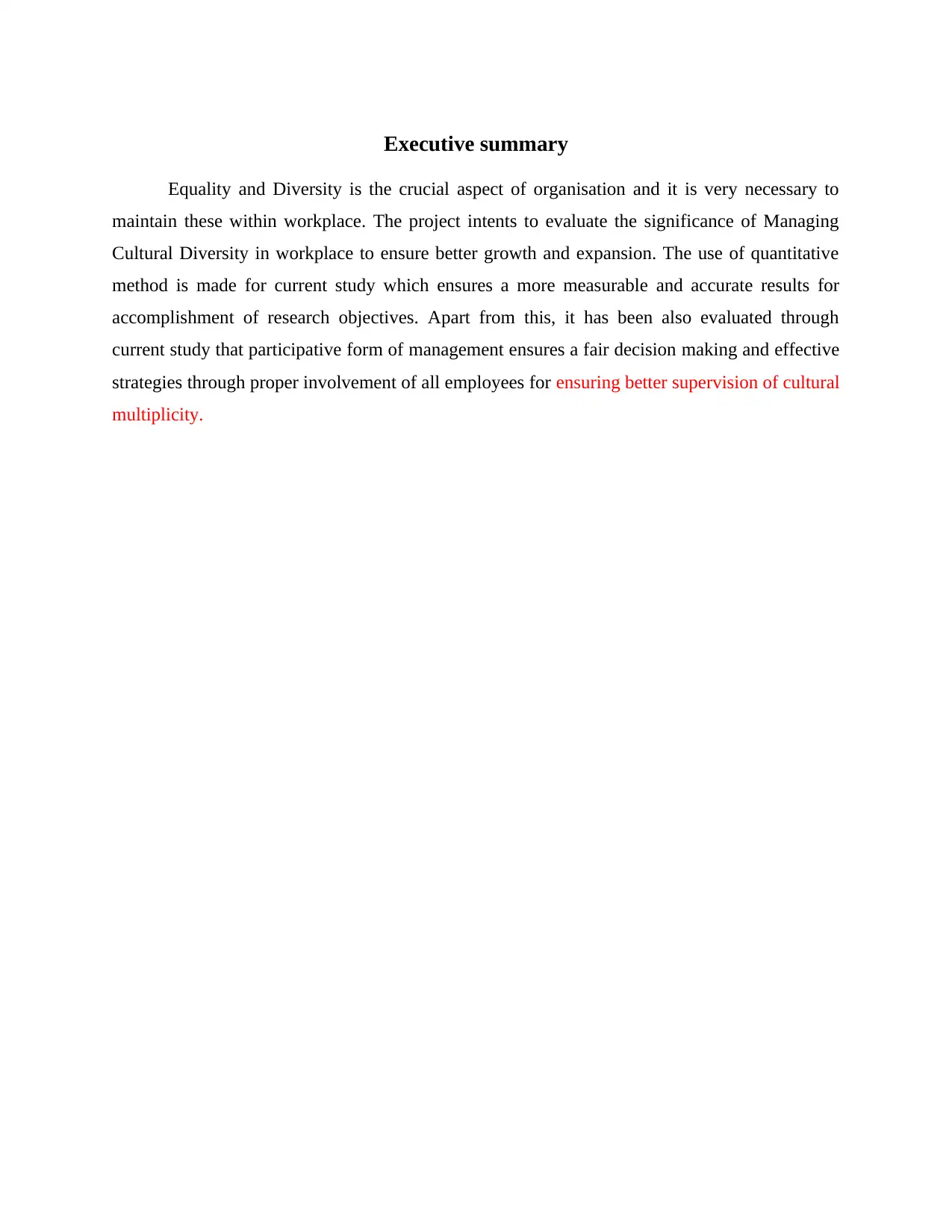
Executive summary
Equality and Diversity is the crucial aspect of organisation and it is very necessary to
maintain these within workplace. The project intents to evaluate the significance of Managing
Cultural Diversity in workplace to ensure better growth and expansion. The use of quantitative
method is made for current study which ensures a more measurable and accurate results for
accomplishment of research objectives. Apart from this, it has been also evaluated through
current study that participative form of management ensures a fair decision making and effective
strategies through proper involvement of all employees for ensuring better supervision of cultural
multiplicity.
Equality and Diversity is the crucial aspect of organisation and it is very necessary to
maintain these within workplace. The project intents to evaluate the significance of Managing
Cultural Diversity in workplace to ensure better growth and expansion. The use of quantitative
method is made for current study which ensures a more measurable and accurate results for
accomplishment of research objectives. Apart from this, it has been also evaluated through
current study that participative form of management ensures a fair decision making and effective
strategies through proper involvement of all employees for ensuring better supervision of cultural
multiplicity.
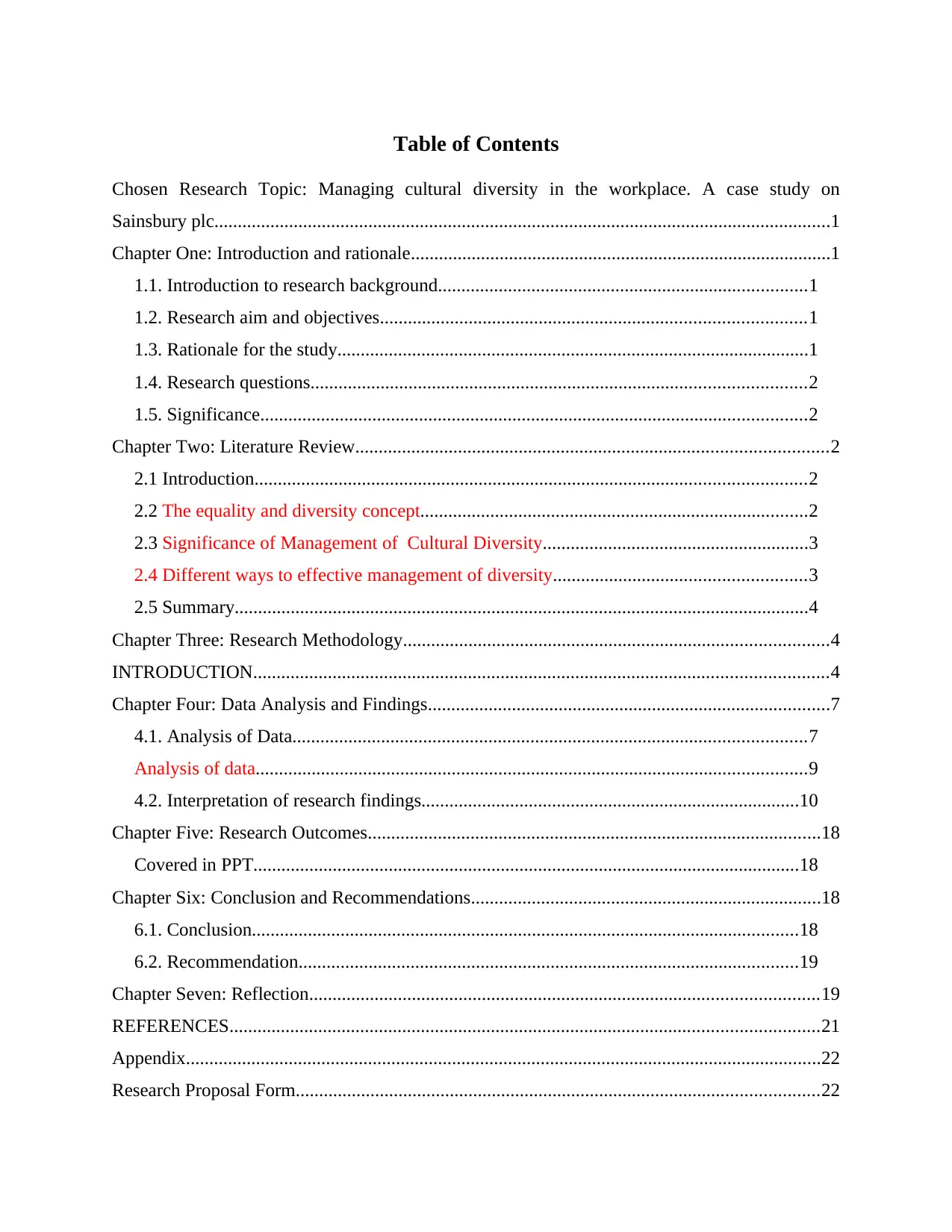
Table of Contents
Chosen Research Topic: Managing cultural diversity in the workplace. A case study on
Sainsbury plc....................................................................................................................................1
Chapter One: Introduction and rationale..........................................................................................1
1.1. Introduction to research background...............................................................................1
1.2. Research aim and objectives...........................................................................................1
1.3. Rationale for the study.....................................................................................................1
1.4. Research questions..........................................................................................................2
1.5. Significance.....................................................................................................................2
Chapter Two: Literature Review.....................................................................................................2
2.1 Introduction......................................................................................................................2
2.2 The equality and diversity concept...................................................................................2
2.3 Significance of Management of Cultural Diversity.........................................................3
2.4 Different ways to effective management of diversity......................................................3
2.5 Summary...........................................................................................................................4
Chapter Three: Research Methodology...........................................................................................4
INTRODUCTION...........................................................................................................................4
Chapter Four: Data Analysis and Findings......................................................................................7
4.1. Analysis of Data..............................................................................................................7
Analysis of data......................................................................................................................9
4.2. Interpretation of research findings.................................................................................10
Chapter Five: Research Outcomes.................................................................................................18
Covered in PPT.....................................................................................................................18
Chapter Six: Conclusion and Recommendations...........................................................................18
6.1. Conclusion.....................................................................................................................18
6.2. Recommendation...........................................................................................................19
Chapter Seven: Reflection.............................................................................................................19
REFERENCES..............................................................................................................................21
Appendix........................................................................................................................................22
Research Proposal Form................................................................................................................22
Chosen Research Topic: Managing cultural diversity in the workplace. A case study on
Sainsbury plc....................................................................................................................................1
Chapter One: Introduction and rationale..........................................................................................1
1.1. Introduction to research background...............................................................................1
1.2. Research aim and objectives...........................................................................................1
1.3. Rationale for the study.....................................................................................................1
1.4. Research questions..........................................................................................................2
1.5. Significance.....................................................................................................................2
Chapter Two: Literature Review.....................................................................................................2
2.1 Introduction......................................................................................................................2
2.2 The equality and diversity concept...................................................................................2
2.3 Significance of Management of Cultural Diversity.........................................................3
2.4 Different ways to effective management of diversity......................................................3
2.5 Summary...........................................................................................................................4
Chapter Three: Research Methodology...........................................................................................4
INTRODUCTION...........................................................................................................................4
Chapter Four: Data Analysis and Findings......................................................................................7
4.1. Analysis of Data..............................................................................................................7
Analysis of data......................................................................................................................9
4.2. Interpretation of research findings.................................................................................10
Chapter Five: Research Outcomes.................................................................................................18
Covered in PPT.....................................................................................................................18
Chapter Six: Conclusion and Recommendations...........................................................................18
6.1. Conclusion.....................................................................................................................18
6.2. Recommendation...........................................................................................................19
Chapter Seven: Reflection.............................................................................................................19
REFERENCES..............................................................................................................................21
Appendix........................................................................................................................................22
Research Proposal Form................................................................................................................22
⊘ This is a preview!⊘
Do you want full access?
Subscribe today to unlock all pages.

Trusted by 1+ million students worldwide

Research Ethics approval form......................................................................................................30
Paraphrase This Document
Need a fresh take? Get an instant paraphrase of this document with our AI Paraphraser

Chosen Research Topic: Managing cultural diversity in the workplace. A case
study on Sainsbury plc
Chapter One: Introduction and rationale
1.1. Introduction to research background
Management of cultural diversity is a viable concept as it brings enhanced teamwork and
ensures right and fair behaviour at workplace which leads to a more creative and motivated
workforce. Management of cultural diversity leads to presence of diversified employees at
workplace which enhance skills of workforce but at the same time many issues and challenges
like communication barriers and conflicts are also lead by this (Ravazzani, 2016). Thus, the
current investigation is lead out on Sainsbury plc which is considered as the second largest
supermarkets chain of the United Kingdom to evaluate about the need and importance of
Managing Cultural Diversity in the workplace.
1.2. Research aim and objectives
Research Aim
“To evaluate about the importance of Managing Cultural Diversity in the workplace to
ensure better growth and expansion”. A research work on Sainsbury plc.
Objectives of research
To have deep insight in the concept of equality and diversity.
To evaluate about the importance of Managing Cultural Diversity in the workplace to
ensure better growth and expansion of Sainsbury plc.
To examine the various ways and steps that could be adopted Sainsbury to ensure
effective management of cultural diversity to have better growth and expansion.
1.3. Rationale for the study
The assortment of current study topic is seemed rationale is it ensures and leads to better
evaluation of the importance of Managing Cultural Diversity in the workplace which is vital
from professional perception of the associated investigator in order to ensure enhanced growth
and expansion of a company (Schouten, Khattab and Pahng, 2020). Beside this, current topic is
also viable from personal interest of researcher along with leading enhanced managerial skills
and better competencies to meet academic and education perspective of investigator.
1
study on Sainsbury plc
Chapter One: Introduction and rationale
1.1. Introduction to research background
Management of cultural diversity is a viable concept as it brings enhanced teamwork and
ensures right and fair behaviour at workplace which leads to a more creative and motivated
workforce. Management of cultural diversity leads to presence of diversified employees at
workplace which enhance skills of workforce but at the same time many issues and challenges
like communication barriers and conflicts are also lead by this (Ravazzani, 2016). Thus, the
current investigation is lead out on Sainsbury plc which is considered as the second largest
supermarkets chain of the United Kingdom to evaluate about the need and importance of
Managing Cultural Diversity in the workplace.
1.2. Research aim and objectives
Research Aim
“To evaluate about the importance of Managing Cultural Diversity in the workplace to
ensure better growth and expansion”. A research work on Sainsbury plc.
Objectives of research
To have deep insight in the concept of equality and diversity.
To evaluate about the importance of Managing Cultural Diversity in the workplace to
ensure better growth and expansion of Sainsbury plc.
To examine the various ways and steps that could be adopted Sainsbury to ensure
effective management of cultural diversity to have better growth and expansion.
1.3. Rationale for the study
The assortment of current study topic is seemed rationale is it ensures and leads to better
evaluation of the importance of Managing Cultural Diversity in the workplace which is vital
from professional perception of the associated investigator in order to ensure enhanced growth
and expansion of a company (Schouten, Khattab and Pahng, 2020). Beside this, current topic is
also viable from personal interest of researcher along with leading enhanced managerial skills
and better competencies to meet academic and education perspective of investigator.
1
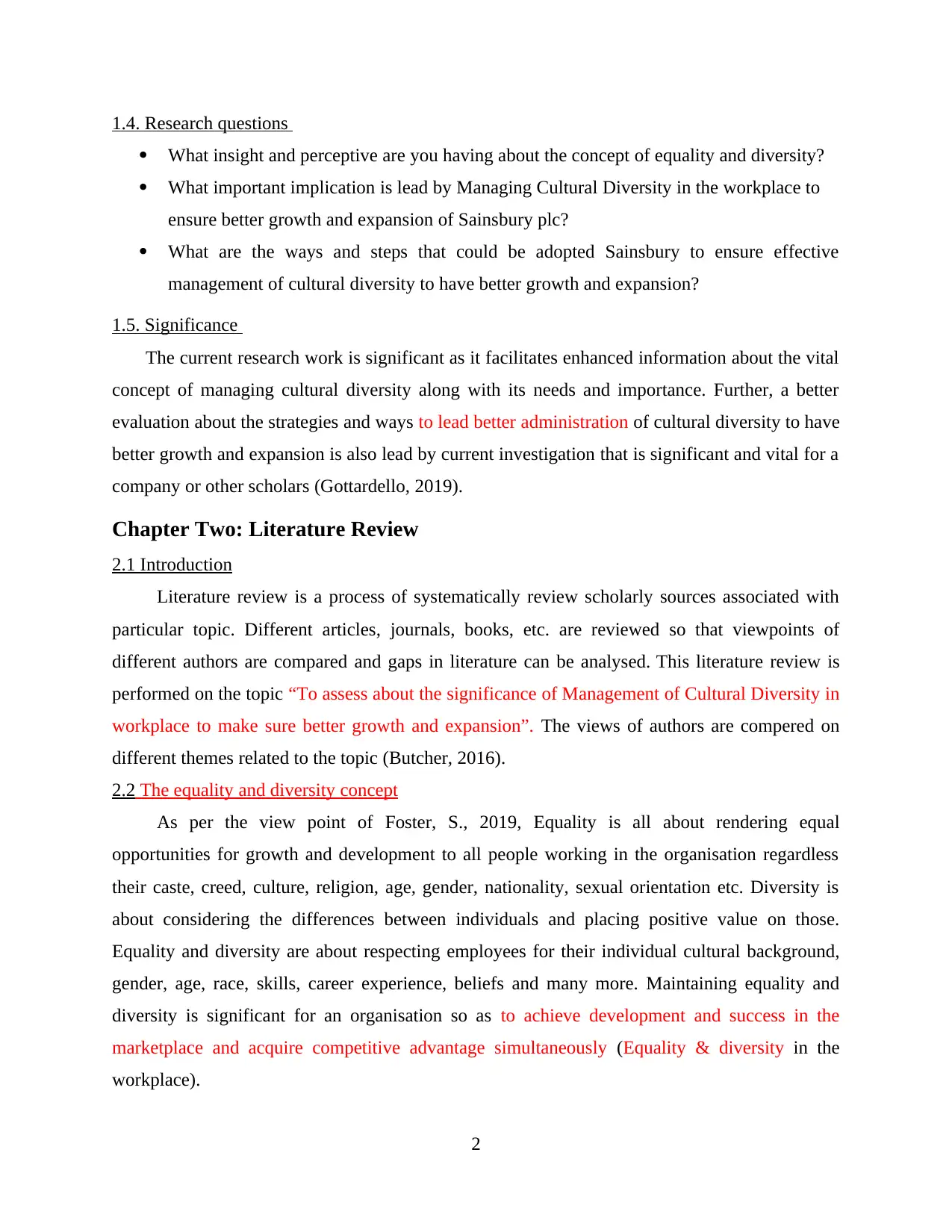
1.4. Research questions
What insight and perceptive are you having about the concept of equality and diversity?
What important implication is lead by Managing Cultural Diversity in the workplace to
ensure better growth and expansion of Sainsbury plc?
What are the ways and steps that could be adopted Sainsbury to ensure effective
management of cultural diversity to have better growth and expansion?
1.5. Significance
The current research work is significant as it facilitates enhanced information about the vital
concept of managing cultural diversity along with its needs and importance. Further, a better
evaluation about the strategies and ways to lead better administration of cultural diversity to have
better growth and expansion is also lead by current investigation that is significant and vital for a
company or other scholars (Gottardello, 2019).
Chapter Two: Literature Review
2.1 Introduction
Literature review is a process of systematically review scholarly sources associated with
particular topic. Different articles, journals, books, etc. are reviewed so that viewpoints of
different authors are compared and gaps in literature can be analysed. This literature review is
performed on the topic “To assess about the significance of Management of Cultural Diversity in
workplace to make sure better growth and expansion”. The views of authors are compered on
different themes related to the topic (Butcher, 2016).
2.2 The equality and diversity concept
As per the view point of Foster, S., 2019, Equality is all about rendering equal
opportunities for growth and development to all people working in the organisation regardless
their caste, creed, culture, religion, age, gender, nationality, sexual orientation etc. Diversity is
about considering the differences between individuals and placing positive value on those.
Equality and diversity are about respecting employees for their individual cultural background,
gender, age, race, skills, career experience, beliefs and many more. Maintaining equality and
diversity is significant for an organisation so as to achieve development and success in the
marketplace and acquire competitive advantage simultaneously (Equality & diversity in the
workplace).
2
What insight and perceptive are you having about the concept of equality and diversity?
What important implication is lead by Managing Cultural Diversity in the workplace to
ensure better growth and expansion of Sainsbury plc?
What are the ways and steps that could be adopted Sainsbury to ensure effective
management of cultural diversity to have better growth and expansion?
1.5. Significance
The current research work is significant as it facilitates enhanced information about the vital
concept of managing cultural diversity along with its needs and importance. Further, a better
evaluation about the strategies and ways to lead better administration of cultural diversity to have
better growth and expansion is also lead by current investigation that is significant and vital for a
company or other scholars (Gottardello, 2019).
Chapter Two: Literature Review
2.1 Introduction
Literature review is a process of systematically review scholarly sources associated with
particular topic. Different articles, journals, books, etc. are reviewed so that viewpoints of
different authors are compared and gaps in literature can be analysed. This literature review is
performed on the topic “To assess about the significance of Management of Cultural Diversity in
workplace to make sure better growth and expansion”. The views of authors are compered on
different themes related to the topic (Butcher, 2016).
2.2 The equality and diversity concept
As per the view point of Foster, S., 2019, Equality is all about rendering equal
opportunities for growth and development to all people working in the organisation regardless
their caste, creed, culture, religion, age, gender, nationality, sexual orientation etc. Diversity is
about considering the differences between individuals and placing positive value on those.
Equality and diversity are about respecting employees for their individual cultural background,
gender, age, race, skills, career experience, beliefs and many more. Maintaining equality and
diversity is significant for an organisation so as to achieve development and success in the
marketplace and acquire competitive advantage simultaneously (Equality & diversity in the
workplace).
2
⊘ This is a preview!⊘
Do you want full access?
Subscribe today to unlock all pages.

Trusted by 1+ million students worldwide
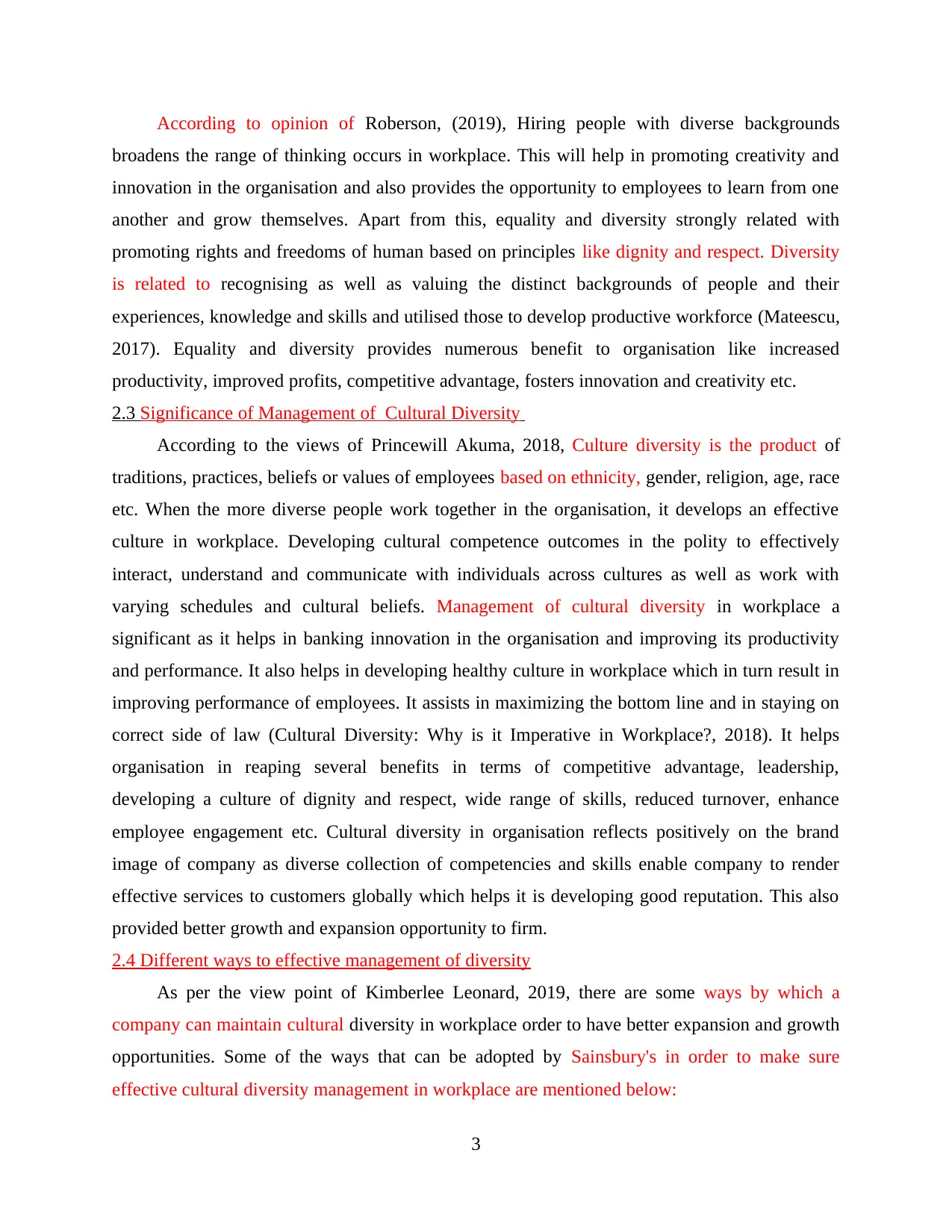
According to opinion of Roberson, (2019), Hiring people with diverse backgrounds
broadens the range of thinking occurs in workplace. This will help in promoting creativity and
innovation in the organisation and also provides the opportunity to employees to learn from one
another and grow themselves. Apart from this, equality and diversity strongly related with
promoting rights and freedoms of human based on principles like dignity and respect. Diversity
is related to recognising as well as valuing the distinct backgrounds of people and their
experiences, knowledge and skills and utilised those to develop productive workforce (Mateescu,
2017). Equality and diversity provides numerous benefit to organisation like increased
productivity, improved profits, competitive advantage, fosters innovation and creativity etc.
2.3 Significance of Management of Cultural Diversity
According to the views of Princewill Akuma, 2018, Culture diversity is the product of
traditions, practices, beliefs or values of employees based on ethnicity, gender, religion, age, race
etc. When the more diverse people work together in the organisation, it develops an effective
culture in workplace. Developing cultural competence outcomes in the polity to effectively
interact, understand and communicate with individuals across cultures as well as work with
varying schedules and cultural beliefs. Management of cultural diversity in workplace a
significant as it helps in banking innovation in the organisation and improving its productivity
and performance. It also helps in developing healthy culture in workplace which in turn result in
improving performance of employees. It assists in maximizing the bottom line and in staying on
correct side of law (Cultural Diversity: Why is it Imperative in Workplace?, 2018). It helps
organisation in reaping several benefits in terms of competitive advantage, leadership,
developing a culture of dignity and respect, wide range of skills, reduced turnover, enhance
employee engagement etc. Cultural diversity in organisation reflects positively on the brand
image of company as diverse collection of competencies and skills enable company to render
effective services to customers globally which helps it is developing good reputation. This also
provided better growth and expansion opportunity to firm.
2.4 Different ways to effective management of diversity
As per the view point of Kimberlee Leonard, 2019, there are some ways by which a
company can maintain cultural diversity in workplace order to have better expansion and growth
opportunities. Some of the ways that can be adopted by Sainsbury's in order to make sure
effective cultural diversity management in workplace are mentioned below:
3
broadens the range of thinking occurs in workplace. This will help in promoting creativity and
innovation in the organisation and also provides the opportunity to employees to learn from one
another and grow themselves. Apart from this, equality and diversity strongly related with
promoting rights and freedoms of human based on principles like dignity and respect. Diversity
is related to recognising as well as valuing the distinct backgrounds of people and their
experiences, knowledge and skills and utilised those to develop productive workforce (Mateescu,
2017). Equality and diversity provides numerous benefit to organisation like increased
productivity, improved profits, competitive advantage, fosters innovation and creativity etc.
2.3 Significance of Management of Cultural Diversity
According to the views of Princewill Akuma, 2018, Culture diversity is the product of
traditions, practices, beliefs or values of employees based on ethnicity, gender, religion, age, race
etc. When the more diverse people work together in the organisation, it develops an effective
culture in workplace. Developing cultural competence outcomes in the polity to effectively
interact, understand and communicate with individuals across cultures as well as work with
varying schedules and cultural beliefs. Management of cultural diversity in workplace a
significant as it helps in banking innovation in the organisation and improving its productivity
and performance. It also helps in developing healthy culture in workplace which in turn result in
improving performance of employees. It assists in maximizing the bottom line and in staying on
correct side of law (Cultural Diversity: Why is it Imperative in Workplace?, 2018). It helps
organisation in reaping several benefits in terms of competitive advantage, leadership,
developing a culture of dignity and respect, wide range of skills, reduced turnover, enhance
employee engagement etc. Cultural diversity in organisation reflects positively on the brand
image of company as diverse collection of competencies and skills enable company to render
effective services to customers globally which helps it is developing good reputation. This also
provided better growth and expansion opportunity to firm.
2.4 Different ways to effective management of diversity
As per the view point of Kimberlee Leonard, 2019, there are some ways by which a
company can maintain cultural diversity in workplace order to have better expansion and growth
opportunities. Some of the ways that can be adopted by Sainsbury's in order to make sure
effective cultural diversity management in workplace are mentioned below:
3
Paraphrase This Document
Need a fresh take? Get an instant paraphrase of this document with our AI Paraphraser
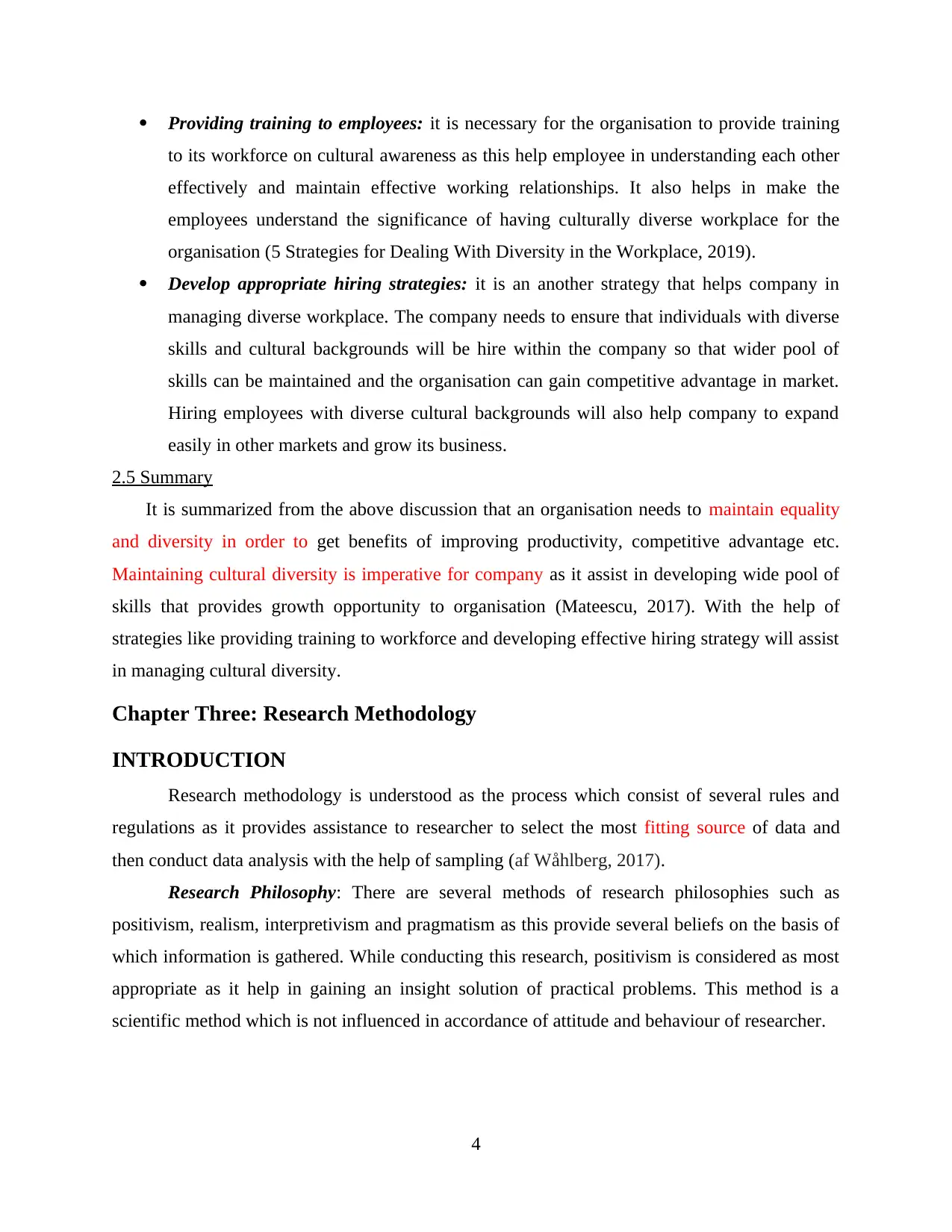
Providing training to employees: it is necessary for the organisation to provide training
to its workforce on cultural awareness as this help employee in understanding each other
effectively and maintain effective working relationships. It also helps in make the
employees understand the significance of having culturally diverse workplace for the
organisation (5 Strategies for Dealing With Diversity in the Workplace, 2019).
Develop appropriate hiring strategies: it is an another strategy that helps company in
managing diverse workplace. The company needs to ensure that individuals with diverse
skills and cultural backgrounds will be hire within the company so that wider pool of
skills can be maintained and the organisation can gain competitive advantage in market.
Hiring employees with diverse cultural backgrounds will also help company to expand
easily in other markets and grow its business.
2.5 Summary
It is summarized from the above discussion that an organisation needs to maintain equality
and diversity in order to get benefits of improving productivity, competitive advantage etc.
Maintaining cultural diversity is imperative for company as it assist in developing wide pool of
skills that provides growth opportunity to organisation (Mateescu, 2017). With the help of
strategies like providing training to workforce and developing effective hiring strategy will assist
in managing cultural diversity.
Chapter Three: Research Methodology
INTRODUCTION
Research methodology is understood as the process which consist of several rules and
regulations as it provides assistance to researcher to select the most fitting source of data and
then conduct data analysis with the help of sampling (af Wåhlberg, 2017).
Research Philosophy: There are several methods of research philosophies such as
positivism, realism, interpretivism and pragmatism as this provide several beliefs on the basis of
which information is gathered. While conducting this research, positivism is considered as most
appropriate as it help in gaining an insight solution of practical problems. This method is a
scientific method which is not influenced in accordance of attitude and behaviour of researcher.
4
to its workforce on cultural awareness as this help employee in understanding each other
effectively and maintain effective working relationships. It also helps in make the
employees understand the significance of having culturally diverse workplace for the
organisation (5 Strategies for Dealing With Diversity in the Workplace, 2019).
Develop appropriate hiring strategies: it is an another strategy that helps company in
managing diverse workplace. The company needs to ensure that individuals with diverse
skills and cultural backgrounds will be hire within the company so that wider pool of
skills can be maintained and the organisation can gain competitive advantage in market.
Hiring employees with diverse cultural backgrounds will also help company to expand
easily in other markets and grow its business.
2.5 Summary
It is summarized from the above discussion that an organisation needs to maintain equality
and diversity in order to get benefits of improving productivity, competitive advantage etc.
Maintaining cultural diversity is imperative for company as it assist in developing wide pool of
skills that provides growth opportunity to organisation (Mateescu, 2017). With the help of
strategies like providing training to workforce and developing effective hiring strategy will assist
in managing cultural diversity.
Chapter Three: Research Methodology
INTRODUCTION
Research methodology is understood as the process which consist of several rules and
regulations as it provides assistance to researcher to select the most fitting source of data and
then conduct data analysis with the help of sampling (af Wåhlberg, 2017).
Research Philosophy: There are several methods of research philosophies such as
positivism, realism, interpretivism and pragmatism as this provide several beliefs on the basis of
which information is gathered. While conducting this research, positivism is considered as most
appropriate as it help in gaining an insight solution of practical problems. This method is a
scientific method which is not influenced in accordance of attitude and behaviour of researcher.
4
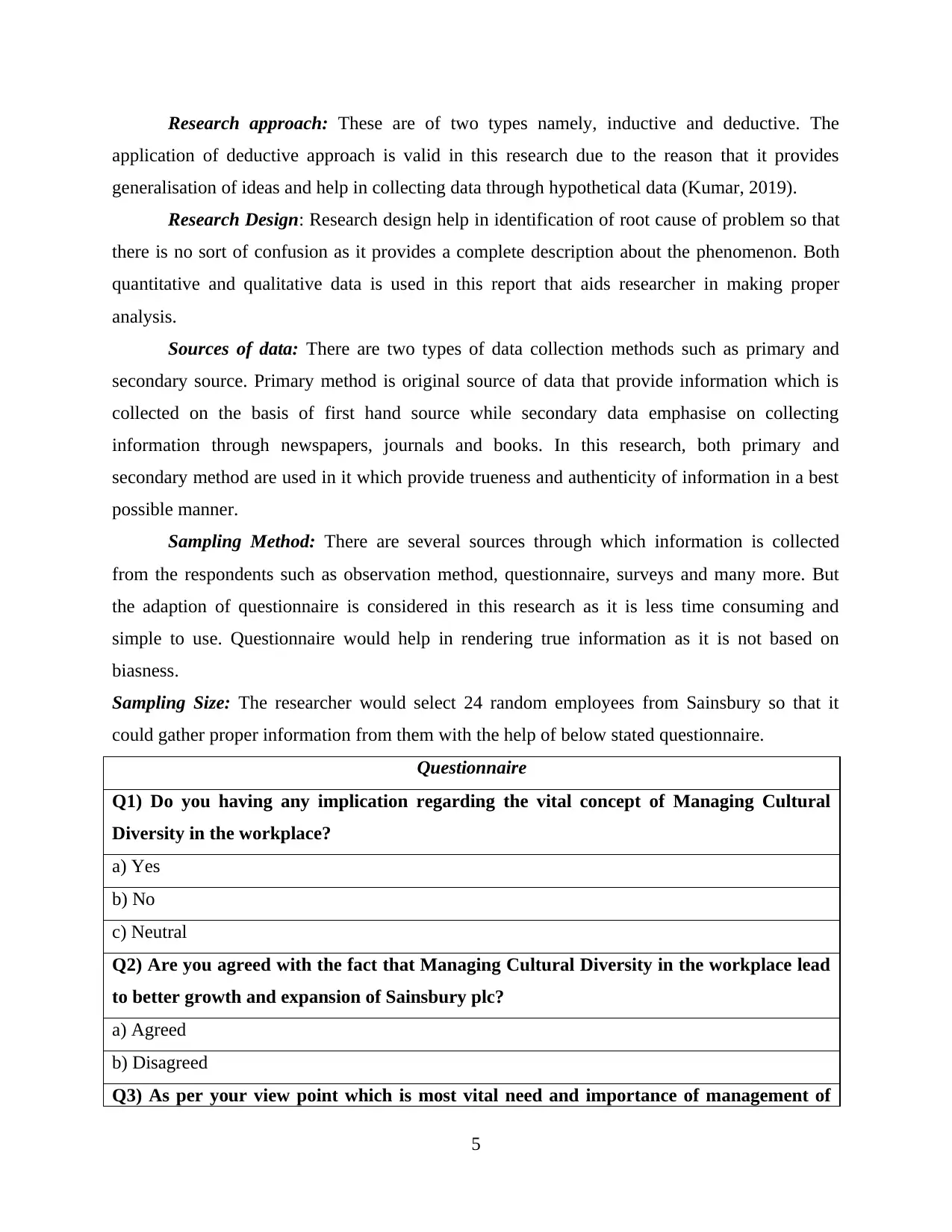
Research approach: These are of two types namely, inductive and deductive. The
application of deductive approach is valid in this research due to the reason that it provides
generalisation of ideas and help in collecting data through hypothetical data (Kumar, 2019).
Research Design: Research design help in identification of root cause of problem so that
there is no sort of confusion as it provides a complete description about the phenomenon. Both
quantitative and qualitative data is used in this report that aids researcher in making proper
analysis.
Sources of data: There are two types of data collection methods such as primary and
secondary source. Primary method is original source of data that provide information which is
collected on the basis of first hand source while secondary data emphasise on collecting
information through newspapers, journals and books. In this research, both primary and
secondary method are used in it which provide trueness and authenticity of information in a best
possible manner.
Sampling Method: There are several sources through which information is collected
from the respondents such as observation method, questionnaire, surveys and many more. But
the adaption of questionnaire is considered in this research as it is less time consuming and
simple to use. Questionnaire would help in rendering true information as it is not based on
biasness.
Sampling Size: The researcher would select 24 random employees from Sainsbury so that it
could gather proper information from them with the help of below stated questionnaire.
Questionnaire
Q1) Do you having any implication regarding the vital concept of Managing Cultural
Diversity in the workplace?
a) Yes
b) No
c) Neutral
Q2) Are you agreed with the fact that Managing Cultural Diversity in the workplace lead
to better growth and expansion of Sainsbury plc?
a) Agreed
b) Disagreed
Q3) As per your view point which is most vital need and importance of management of
5
application of deductive approach is valid in this research due to the reason that it provides
generalisation of ideas and help in collecting data through hypothetical data (Kumar, 2019).
Research Design: Research design help in identification of root cause of problem so that
there is no sort of confusion as it provides a complete description about the phenomenon. Both
quantitative and qualitative data is used in this report that aids researcher in making proper
analysis.
Sources of data: There are two types of data collection methods such as primary and
secondary source. Primary method is original source of data that provide information which is
collected on the basis of first hand source while secondary data emphasise on collecting
information through newspapers, journals and books. In this research, both primary and
secondary method are used in it which provide trueness and authenticity of information in a best
possible manner.
Sampling Method: There are several sources through which information is collected
from the respondents such as observation method, questionnaire, surveys and many more. But
the adaption of questionnaire is considered in this research as it is less time consuming and
simple to use. Questionnaire would help in rendering true information as it is not based on
biasness.
Sampling Size: The researcher would select 24 random employees from Sainsbury so that it
could gather proper information from them with the help of below stated questionnaire.
Questionnaire
Q1) Do you having any implication regarding the vital concept of Managing Cultural
Diversity in the workplace?
a) Yes
b) No
c) Neutral
Q2) Are you agreed with the fact that Managing Cultural Diversity in the workplace lead
to better growth and expansion of Sainsbury plc?
a) Agreed
b) Disagreed
Q3) As per your view point which is most vital need and importance of management of
5
⊘ This is a preview!⊘
Do you want full access?
Subscribe today to unlock all pages.

Trusted by 1+ million students worldwide
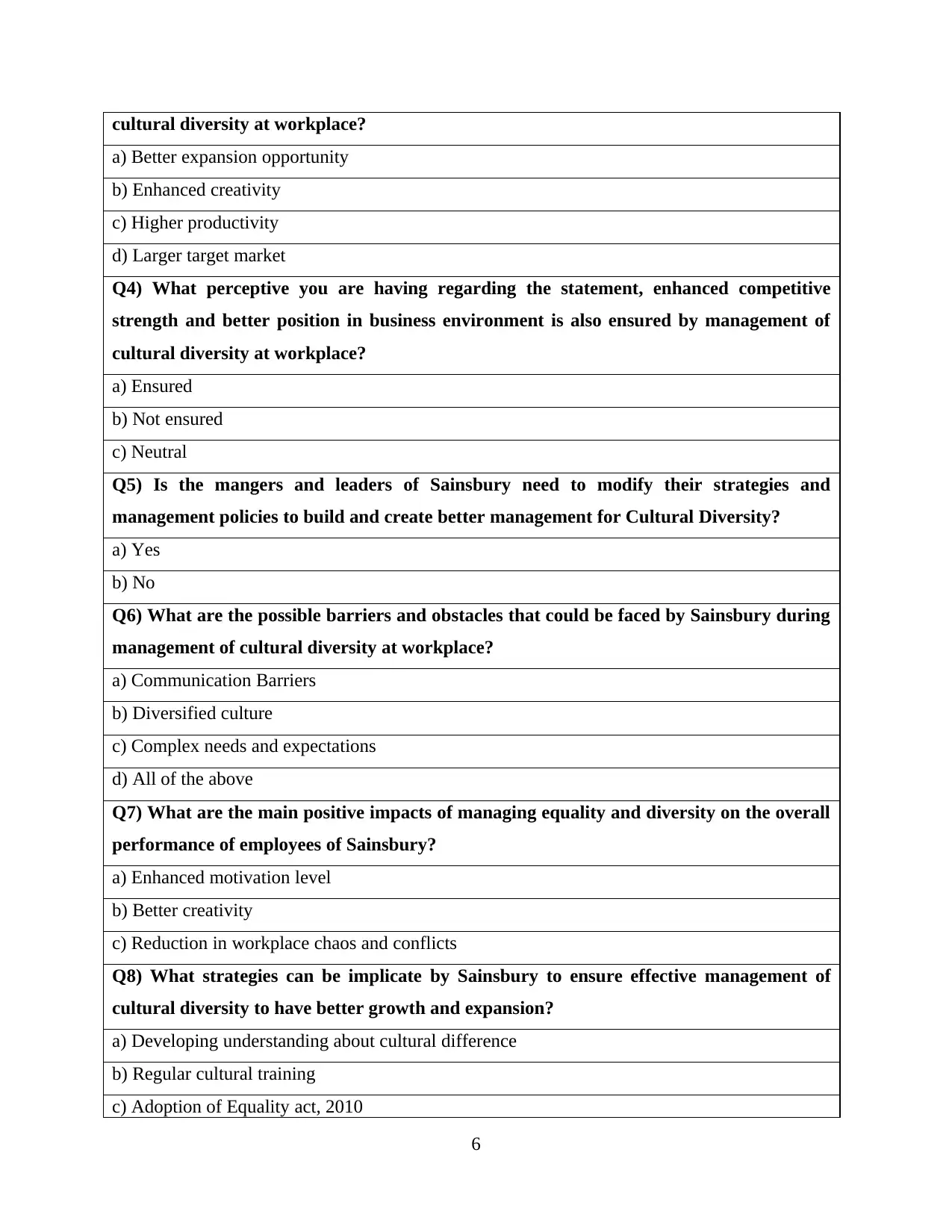
cultural diversity at workplace?
a) Better expansion opportunity
b) Enhanced creativity
c) Higher productivity
d) Larger target market
Q4) What perceptive you are having regarding the statement, enhanced competitive
strength and better position in business environment is also ensured by management of
cultural diversity at workplace?
a) Ensured
b) Not ensured
c) Neutral
Q5) Is the mangers and leaders of Sainsbury need to modify their strategies and
management policies to build and create better management for Cultural Diversity?
a) Yes
b) No
Q6) What are the possible barriers and obstacles that could be faced by Sainsbury during
management of cultural diversity at workplace?
a) Communication Barriers
b) Diversified culture
c) Complex needs and expectations
d) All of the above
Q7) What are the main positive impacts of managing equality and diversity on the overall
performance of employees of Sainsbury?
a) Enhanced motivation level
b) Better creativity
c) Reduction in workplace chaos and conflicts
Q8) What strategies can be implicate by Sainsbury to ensure effective management of
cultural diversity to have better growth and expansion?
a) Developing understanding about cultural difference
b) Regular cultural training
c) Adoption of Equality act, 2010
6
a) Better expansion opportunity
b) Enhanced creativity
c) Higher productivity
d) Larger target market
Q4) What perceptive you are having regarding the statement, enhanced competitive
strength and better position in business environment is also ensured by management of
cultural diversity at workplace?
a) Ensured
b) Not ensured
c) Neutral
Q5) Is the mangers and leaders of Sainsbury need to modify their strategies and
management policies to build and create better management for Cultural Diversity?
a) Yes
b) No
Q6) What are the possible barriers and obstacles that could be faced by Sainsbury during
management of cultural diversity at workplace?
a) Communication Barriers
b) Diversified culture
c) Complex needs and expectations
d) All of the above
Q7) What are the main positive impacts of managing equality and diversity on the overall
performance of employees of Sainsbury?
a) Enhanced motivation level
b) Better creativity
c) Reduction in workplace chaos and conflicts
Q8) What strategies can be implicate by Sainsbury to ensure effective management of
cultural diversity to have better growth and expansion?
a) Developing understanding about cultural difference
b) Regular cultural training
c) Adoption of Equality act, 2010
6
Paraphrase This Document
Need a fresh take? Get an instant paraphrase of this document with our AI Paraphraser
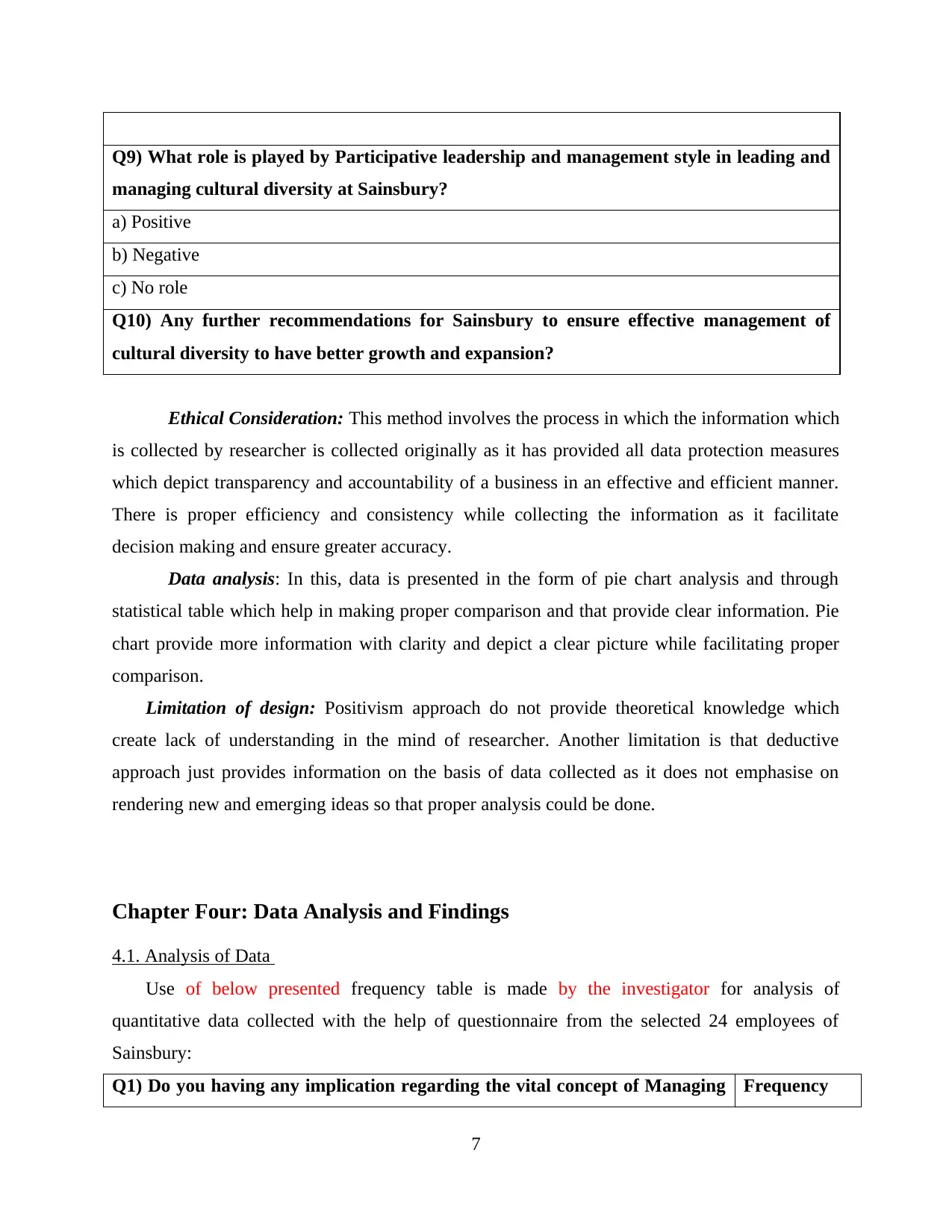
Q9) What role is played by Participative leadership and management style in leading and
managing cultural diversity at Sainsbury?
a) Positive
b) Negative
c) No role
Q10) Any further recommendations for Sainsbury to ensure effective management of
cultural diversity to have better growth and expansion?
Ethical Consideration: This method involves the process in which the information which
is collected by researcher is collected originally as it has provided all data protection measures
which depict transparency and accountability of a business in an effective and efficient manner.
There is proper efficiency and consistency while collecting the information as it facilitate
decision making and ensure greater accuracy.
Data analysis: In this, data is presented in the form of pie chart analysis and through
statistical table which help in making proper comparison and that provide clear information. Pie
chart provide more information with clarity and depict a clear picture while facilitating proper
comparison.
Limitation of design: Positivism approach do not provide theoretical knowledge which
create lack of understanding in the mind of researcher. Another limitation is that deductive
approach just provides information on the basis of data collected as it does not emphasise on
rendering new and emerging ideas so that proper analysis could be done.
Chapter Four: Data Analysis and Findings
4.1. Analysis of Data
Use of below presented frequency table is made by the investigator for analysis of
quantitative data collected with the help of questionnaire from the selected 24 employees of
Sainsbury:
Q1) Do you having any implication regarding the vital concept of Managing Frequency
7
managing cultural diversity at Sainsbury?
a) Positive
b) Negative
c) No role
Q10) Any further recommendations for Sainsbury to ensure effective management of
cultural diversity to have better growth and expansion?
Ethical Consideration: This method involves the process in which the information which
is collected by researcher is collected originally as it has provided all data protection measures
which depict transparency and accountability of a business in an effective and efficient manner.
There is proper efficiency and consistency while collecting the information as it facilitate
decision making and ensure greater accuracy.
Data analysis: In this, data is presented in the form of pie chart analysis and through
statistical table which help in making proper comparison and that provide clear information. Pie
chart provide more information with clarity and depict a clear picture while facilitating proper
comparison.
Limitation of design: Positivism approach do not provide theoretical knowledge which
create lack of understanding in the mind of researcher. Another limitation is that deductive
approach just provides information on the basis of data collected as it does not emphasise on
rendering new and emerging ideas so that proper analysis could be done.
Chapter Four: Data Analysis and Findings
4.1. Analysis of Data
Use of below presented frequency table is made by the investigator for analysis of
quantitative data collected with the help of questionnaire from the selected 24 employees of
Sainsbury:
Q1) Do you having any implication regarding the vital concept of Managing Frequency
7
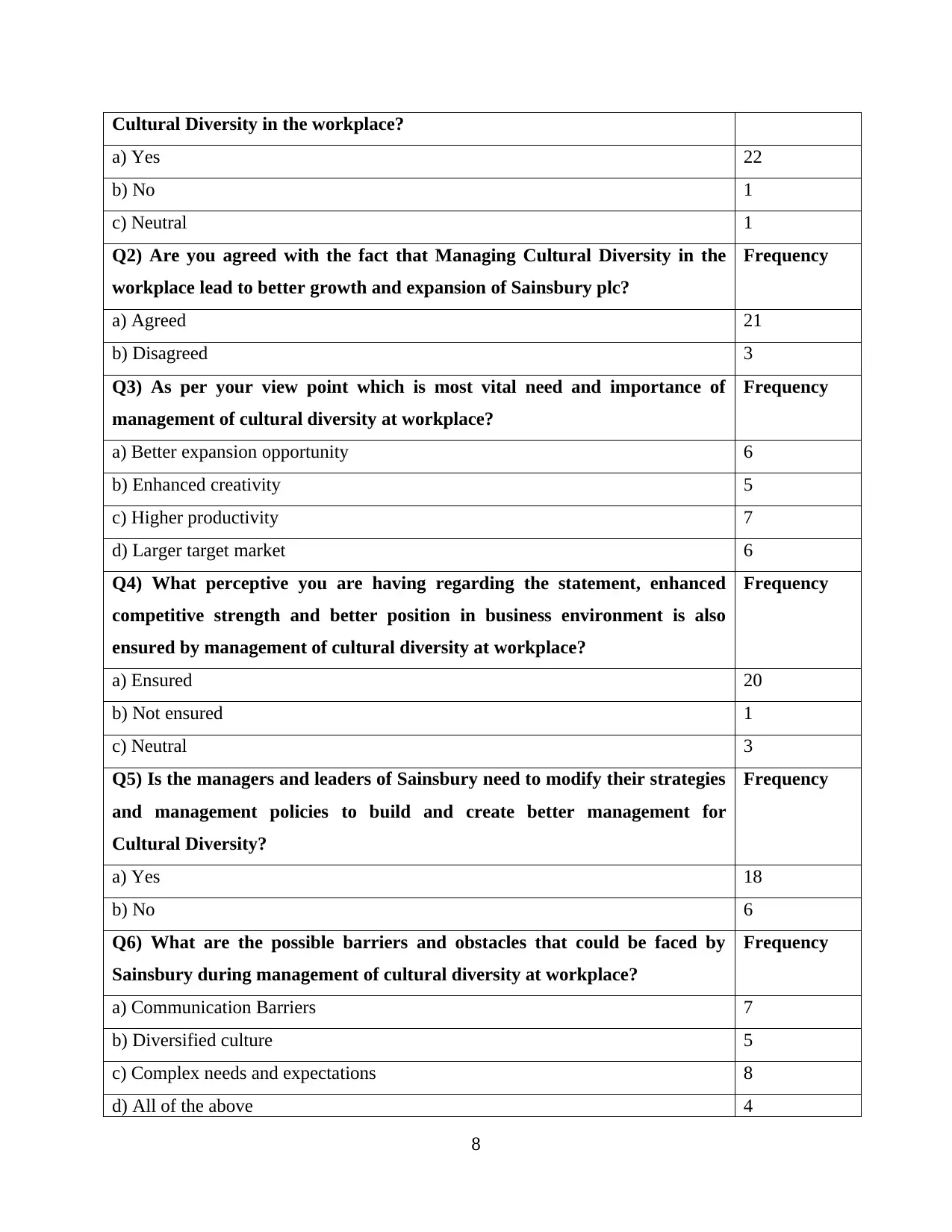
Cultural Diversity in the workplace?
a) Yes 22
b) No 1
c) Neutral 1
Q2) Are you agreed with the fact that Managing Cultural Diversity in the
workplace lead to better growth and expansion of Sainsbury plc?
Frequency
a) Agreed 21
b) Disagreed 3
Q3) As per your view point which is most vital need and importance of
management of cultural diversity at workplace?
Frequency
a) Better expansion opportunity 6
b) Enhanced creativity 5
c) Higher productivity 7
d) Larger target market 6
Q4) What perceptive you are having regarding the statement, enhanced
competitive strength and better position in business environment is also
ensured by management of cultural diversity at workplace?
Frequency
a) Ensured 20
b) Not ensured 1
c) Neutral 3
Q5) Is the managers and leaders of Sainsbury need to modify their strategies
and management policies to build and create better management for
Cultural Diversity?
Frequency
a) Yes 18
b) No 6
Q6) What are the possible barriers and obstacles that could be faced by
Sainsbury during management of cultural diversity at workplace?
Frequency
a) Communication Barriers 7
b) Diversified culture 5
c) Complex needs and expectations 8
d) All of the above 4
8
a) Yes 22
b) No 1
c) Neutral 1
Q2) Are you agreed with the fact that Managing Cultural Diversity in the
workplace lead to better growth and expansion of Sainsbury plc?
Frequency
a) Agreed 21
b) Disagreed 3
Q3) As per your view point which is most vital need and importance of
management of cultural diversity at workplace?
Frequency
a) Better expansion opportunity 6
b) Enhanced creativity 5
c) Higher productivity 7
d) Larger target market 6
Q4) What perceptive you are having regarding the statement, enhanced
competitive strength and better position in business environment is also
ensured by management of cultural diversity at workplace?
Frequency
a) Ensured 20
b) Not ensured 1
c) Neutral 3
Q5) Is the managers and leaders of Sainsbury need to modify their strategies
and management policies to build and create better management for
Cultural Diversity?
Frequency
a) Yes 18
b) No 6
Q6) What are the possible barriers and obstacles that could be faced by
Sainsbury during management of cultural diversity at workplace?
Frequency
a) Communication Barriers 7
b) Diversified culture 5
c) Complex needs and expectations 8
d) All of the above 4
8
⊘ This is a preview!⊘
Do you want full access?
Subscribe today to unlock all pages.

Trusted by 1+ million students worldwide
1 out of 37
Related Documents
Your All-in-One AI-Powered Toolkit for Academic Success.
+13062052269
info@desklib.com
Available 24*7 on WhatsApp / Email
![[object Object]](/_next/static/media/star-bottom.7253800d.svg)
Unlock your academic potential
Copyright © 2020–2025 A2Z Services. All Rights Reserved. Developed and managed by ZUCOL.




